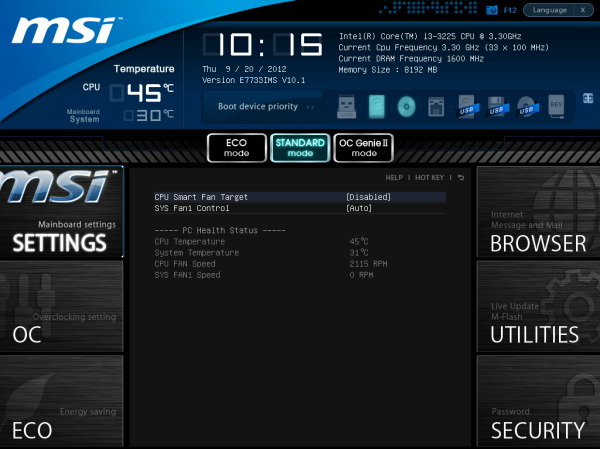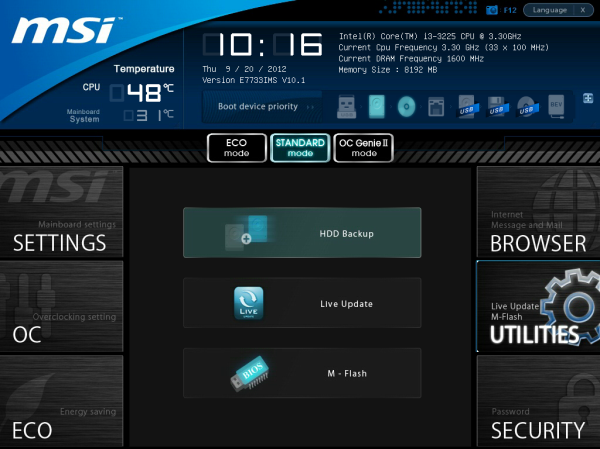Z77 mITX Round-Up: Five of the Best – MSI, Zotac, ASRock, EVGA and ASUS
by Ian Cutress on December 31, 2012 7:00 AM EST- Posted in
- Motherboards
- MSI
- ASRock
- EVGA
- ZOTAC
- Asus
- Ivy Bridge
- Z77
- mITX
MSI Z77IA-E53 BIOS
In the land of the evolving BIOS, one everlasting memory of MSI will stick with me always – the propensity for MSI to include games in the BIOS. Back on the initial launch of graphical interface BIOSes (UEFIs) on the P67 chipset, MSI’s initial design was to offer a series of options using colors, but also to include a section involving simple games like Breakout, Pairs, and some Snake derivative. While a baffling situation for any reviewer to be in, it did point out the obvious nature of what a graphical BIOS should be – interactive, appealing and easy to use. As a technical exercise, the games did their job, but the games were clearly not going to stay.
Since then, MSI have taken two steps forward is aesthetics, but two steps back in accessibility and design. What we have had since X79 is literally a ‘winning’ design – technically the third place in an internal competition at MSI to design the next BIOS (those that came first and second were apparently not suitable for implementation). This BIOS is great for information – at the front screen we get vital information that should be in any BIOS: the motherboard and BIOS version, the CPU and CPU speed, the memory count and speed, and the CPU temperature. We also have access to some secondary important characteristics such as boot order, time and date.
The downside in the BIOS lies in the selection of options. Choosing a menu on the side of the BIOS merely gives a textual list of all there is to offer. It does not embrace the spirit of interaction, and when faced with a wall of text (such as the OC menu), it is not pleasing to decipher. To use a baseball analogy, the MSI system is neither a hit nor a strike out/pop-fly – I see it more as a 4-ball walk: enough to get to first base and potential to develop, but could do better.
The options available in the BIOS seem to come from two different sides of the development team. In the Settings Menu we get access to several sub-menus, each relating to their corresponding target – USB Configuration, Hardware Monitor, Power Management et al. In the OC menu however, as shown above, we are presented with the aforementioned wall of text. Each option is on a new line, and no separation between the CPU options, the OCP options, the LLC options, the memory options, and so on. Not only this, some of the options could be construed as confusing at first glance (such as Digital Compensation Level, which may well be VDroop, LLC, or some other term) unless you are completely au fait with MSI terminology. The BIOS does not offer any assistance in learning what each of these commands mean, or whether an extreme overclocker needs 0% or 100% for a particular command as different manufacturers have different interpretations. I would instigate a redesign if I got hold of this BIOS code.
Being a motherboard, controlling the fans is important. As mentioned before, our fans are controlled through the Fintek SuperIO chip – on the MSI Z77IA-E53 this gives our CPU and SYS fan headers two different types of option. The CPU header is a ‘Smart’ target, which allows us to specify a simple gradient between two optimal temperatures. The SYS fan header in comparison is limited in its speed range, leaving it with a fixed RPM.
Most of the options in this BIOS are no different than options in other vendors’ BIOSes – AHCI is enabled by default, as are the WiFi and Bluetooth modules. The mSATA/mPCIe slot defaults to automatic and should detect any device attached correctly. There are no automatic overclocking options except ‘OC Genie II mode’, clickable at the top. In the Utilities menu we can activate a BIOS update via a USB stick, or offer a Live Update via the internet if a suitable network configuration is supported.




















54 Comments
View All Comments
IanCutress - Monday, December 31, 2012 - link
Gigabyte wanted their H77 reviewed instead, which we reviewed recently: http://www.anandtech.com/show/6427Athelstan - Monday, December 31, 2012 - link
Thanks for the review. I'm curious why you mention the audio chip on all of these board. For the intended purpose, wouldn't the audio be over HDMI, making the onboard audio unused in most cases? Even then, all of the boards have optical out, making the audio chip to have very little to do other than to pass along the bitstream from the media thought the optical connection.IanCutress - Monday, December 31, 2012 - link
The audio chip also controls the front panel audio, and even if the audio was going through the HDMI, external speakers for a HTPC may be used via the audio jacks. In my personal usage scenario, my video out is via DVI-D to a 2560x1440 Korean panel via a dGPU, meaning all my audio still goes through the normal audio jacks. The other reason is that if I did not mention it, someone in the comments would ask why wasn't the audio chip mentioned. There is a price difference between the ALC889, ALC892 and ALC898, though manufacturers obviously get these on bulk deals (or at a discount when bought with the Realtek 8111E/F) and I am not privy to that information.Ian
Taft12 - Monday, December 31, 2012 - link
Speaking of audio, could you let us know the differences between those 3 Realtek audio chipsets? Is there any sound quality difference, or is it only features?mczak - Monday, December 31, 2012 - link
The 892 has somewhat crappy ADC/DACs quality-wise (that said most likely signal routing etc. on the board will have a much bigger effect on sound quality than the quality of the DACs, so using a higher quality chip can still easily result in worse quality than using a cheap chip with more care taken). The 889 and 898 seem quite similar there on paper.I think just about the only thing you'd really miss is the dolby digital live / dts connect features (encode multichannel audio to digital if you're using the digital outputs). But these are pure software features, so you can get them with the 892 as well - I believe though the board manufacturers are more likely to license them with the more expensive chips (I don't know if you could "upgrade" your chip with unofficial means there...). Realtek actually seems to list different ordering numbers depending on these features - interestingly there while all 3 of these chips are listed as a version without any of DDL/DTS Connect, only the 889 has a version with both of them, while the 892 only has a version with DTS Connect, and the 898 only has the version without them - the datasheet still lists those features as optional however.so maybe they just stopped using different ordering numbers (the 889 clearly is the oldest of the 3).
Athelstan - Monday, December 31, 2012 - link
*grins* Good point. If you don't mention it someone else would be asking for it.Stacey Melissa - Monday, December 31, 2012 - link
I'm running the ASUS board, and installed the AI Suite for a different ASUS Z77 board in order to get access to Fan Expert 2, which has far better fan control than v.1. Wish I could remember which Z77 board it was, but all I did was check the download pages for various Z77 boards to find one that included AI Suite with Fan Expert 2.IanCutress - Monday, December 31, 2012 - link
MSI include a program as part of the package to update the software, making sure you have the latest available. ASUS and Gigabyte need to do this ASAP, so people can take advantage of things like Fan Expert 2 without having to visit the website. System integrators often just install the drivers and software on the CD when selling a system, and then the user never updates it unless told to by either (a) friends or (b) the software itself.Ian
mfenn - Monday, December 31, 2012 - link
Am I the only one who is getting tired of the liberal copy-pasting of content between motherboard (and SSD) reviews on this site? I don't need to waste my time reading about the MSI design competition in every single review.I understand the need to provide background information to readers who may not peruse every single review, but that's why Tim invented the hyperlink. Link to the old review or to a purpose-built "company profile" page.
Sabresiberian - Tuesday, January 1, 2013 - link
Adding info some may be familiar with is preferable to leaving it out. If you don't want to read it, then I suggest you just skim or skip it entirely. :)